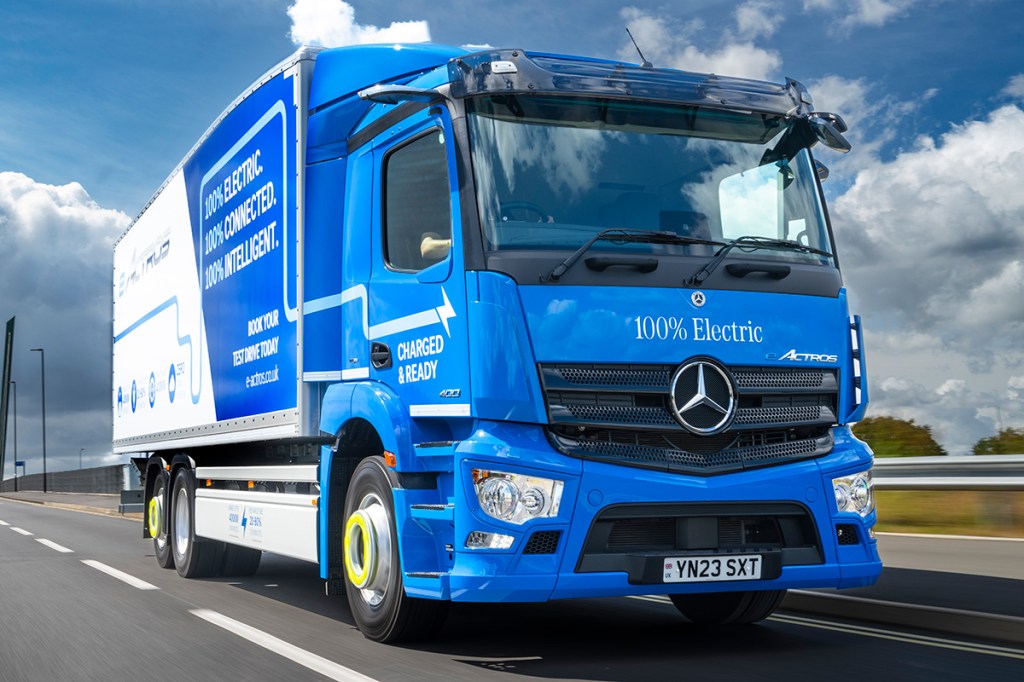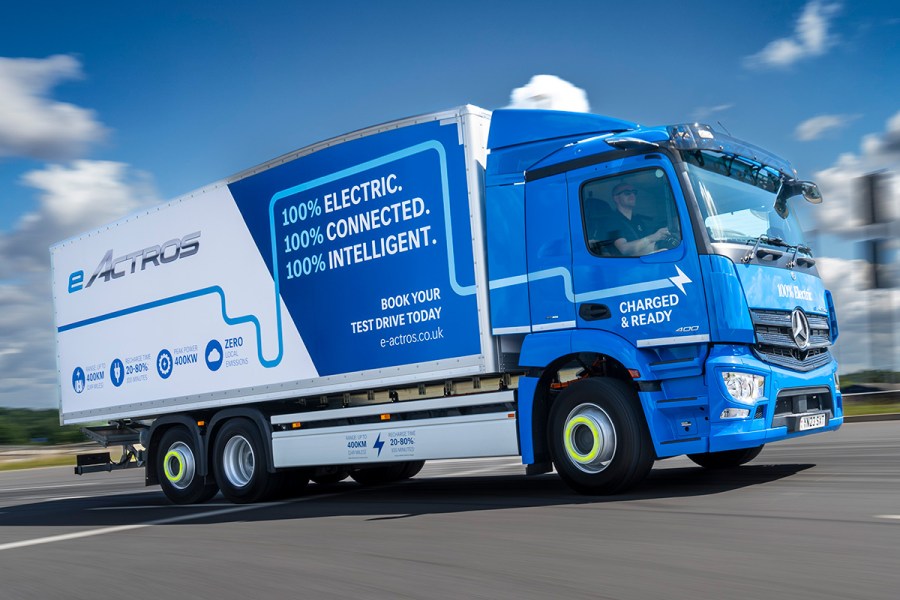Electric trucks are no longer a novelty but are still a way off becoming the norm. However, there are many applications where they could be the solution you are looking for. Trucking took a 27-tonne Mercedes eActros 400 out for a long drive. By Pip Dunn
I might be a bit late to the party, but I’ve not had too much experience driving electric trucks. A body-less spin in a Mercedes eActros 300 a few months ago (which was mainly to try out the Version 2 MirrorCam) and a short drive in a Volvo eFL last year is pretty much the total of my ‘serious’ driving of this form of truck. I think, however, that will change quite a bit over the forthcoming months and years.
So when Mercedes invited me to drive a leg of its participation in a ‘Five Capitals’ EV rally from Cardiff to Dublin via London, Edinburgh and Belfast in an eActros 400, I jumped at the chance. I was to handle the second leg Heathrow to Leicester via a call into Central London, then a dash up the M1. And it did turn out to be a dash.
It was strange travelling to Heathrow Airport and not getting a plane! Instead, I left the airport and managed to walk to where I was meeting Jamie Fretwell from Mercedes, who was piloting the 6×2 27-tonne rigid.
I got there in good time, and even after negotiating the hassle of walking to the Hertz Rental site (good for my step count!), it was 11:00 when I finally walked through the door, which isn’t bad as I was told to be there from 11:00-11:30.
However, there was a delay. The preceding journalist was meant to drive the truck to me here and changeover. Except he’d had enough and asked to be dropped off at a mainline station, so the truck was detoured into Reading! Annoyingly if I had known this was going to happen, I could have gone to Reading instead!
It was 13:30 when YN23 SXT arrived, by that time I’d drunk more coffee and eaten more high-quality cookies and cakes than was sensible for a man in my condition!
This was a chance for me to get to grips with an electric truck and see how it would perform on the 100-plus miles to Leicester with some city driving, a lengthy stretch on the congested M1 and then some cross-country driving via Kettering.
Quiet times
There’s an alarming amount of animosity and hatred towards electric vehicles, both cars and lorries, and I’m not sure why. At the end of the day, so long that it does the job, and does so efficiently, then does it matter what fuel you put in it your vehicle?
Yes, I like the sound of a nice diesel. But having been woken up on a sleeper test recently at 03:00 by a truck with a running fridge trailer pulling right alongside me made me think the switch to quiet electric power can’t come soon enough.
I’m not sure why all this ‘hatred’ exists. I think we need to move the green agenda forward, but, as I have said several times before, it needs to be driven at a governmental level to build the infrastructure. There’s no point urging hauliers to go electric if there are insufficient charging points nationwide.
But let’s not get too bogged down on that just yet, let’s look at the pros and cons of this nice Mercedes lorry first and foremost, is it any good?

Technical overview
From the outside, the truck looks pretty much like any other Mercedes Actros 6×2 rigid. Without looking at the badges, you’d easily be forgiven for thinking this was a 2632, 2636 or even a 2640 diesel. The batteries are mounted to the chassis and hidden by side skirts, so apart from things like the charging plug socket – which is also covered, there’s not much to tell you it’s electric. Apart from the bold and brash advertising branding on the side of the box van!
It has the 2.3m-wide M cab, which is the extended day cab – there is a decent amount of room behind the seats for storage, personal effects or even a fold-down bunk. Apart from the optional leather seats, which few day cab Actros drivers will have specified, this is the cab you’ll see on many a Merc rigid (and the odd tractor unit, such as in the fuel delivery sector). It’s relatively basic, with no frills, but a good place to work in for general multi-drop distribution.
It has the same multimedia digital dash ‘cockpit’ as any Version 5 Actros and has Merc’s MirrorCam system, which has been in production for five years now and is now on its second, much-improved version.
Of course, there is no engine, so it’s ultra-quiet inside. Power comes from two motors, which are integrated into the eAxle, with a 400kW peak power and a 330kW continuous rating – to give you a comparison, that’s 536hp peak and 442hp continuous. No one specifies a diesel truck as a three-axle rigid with that kind of power from a diesel engine!
It is worth reminding you that a three-axle rigid like this – a 6×2 with a single drive axle ahead of the trailing ‘tag’ axle’ can legally gross 26 tonnes in the UK, however for electric trucks, to compensate for the lost payload due to the weight of the batteries and motors, they can legally gross at 27 tonnes.
The gearbox is also a bit different! No 12-speed automated manual here – the truck has just a two-speed automatic gearbox with two forward and two reverse ratios!
There are four 112kWh batteries to power those motors, of which 97kWh is useable. That’s kilowatt hours and the measurement of ‘fuel’ you need to be keeping your eye on! So that gives a total battery capacity of 448kWh installed, of which 388kWh is useable.
What does that mean for the range? Mercedes claims that’s up to 400km (249 miles) with 50% payload between charges. As I was to find out, the truth is, rather better than that. However, I should stress there wasn’t any load on it. Fully freighted would have been a different story. More on that later…
The truck has an 8,000kg front axle, 11,500kg drive axle and 7,500kg tag axle and was fitted with 315/70R 22.5 types.
With its Bevans Box with DEL tuck-under tail-lift from DEL and all the batteries and other gubbins to make it work, it tipped the scales at 12,720kg, which, for 27 tonnes, gives a very useable 14,280kg of payload.
Recharging the truck is easy – assuming the infrastructure is there – you simply lift the flap on, plug in and away you go.
Merc’s plan for day 1 of the EV rally was Cardiff to Nottingham via London, a distance of some 306 miles. Day 2 was Nottingham to Edinburgh, some 316 miles, while Day 3 was Edinburgh to Belfast via Stranraer, just 128 miles of road driving. Day 4 was Belfast to Newry, but via Giants Causeway, so 169 miles is way more than a simple drive between these two cities. Finally, day 5 was 203 miles from Newry to Dublin, although, again, not quite direct as it went via the Wicklow Mountains National Park. All in that was 1,123 miles over the five days.
Charging was done at the end of each day, so as you see, days 1 and 2 were certainly challenging, and each day had several checkpoints – which also offered an opportunity to top up the charge if necessary.
The maximum charging rate for the truck is 160kW, and it takes 1hr 40min to go from 20% to 80% charge. Once you get used to electric trucks you can work your day around their range capabilities, but there are obviously many factors to consider to determine how many miles you’ll get out of a full charge, such as load, terrain, weather and speed. Foot to the floor, fully loaded on a hilly road will obviously drain the battery much quicker than a steady drive when partially loaded and on a flat road.
The eActros has three power ratings – Economy, Normal or Power which are pretty self-explanatory
On the road
My stint was about 120 miles all in and started with negotiating the roads around Heathrow airport.
The dash was the familiar Multimedia Cockpit with the Interactive 12.3in central touchscreen and 12.3in digital instrument cluster, so apart from some of the features to marry up with it being an electric truck, I’m already familiar with it. And, of course, it had Merc’s impressive MirrorCam – of which I am a huge fan.
With no load on, it handled very well and was exceptionally quick out of the blocks, as electric trucks tend to be, hardly surprising given the power available. The e400 model I’d driven a while back had been like a dodgem car in the sense you had to keep your foot on the accelerator, or it would automatically brake. This truck was more like a diesel truck because you use the accelerator to do just that. But take your foot off it, and it keeps going, it doesn’t actively start to brake.
Obviously, it’s incredibly quiet, which takes a little bit of getting used to, but does allow for a lovely peaceful drive. It handles well and brakes well. It’s as easy, if not easier, to handle than a diesel equivalent, although you have to watch the initial acceleration and the speed – it’s easy to be doing 40 in a 30 or 50 in a 40mph zone, so keep an eye on that.
Driving around the busy roads of London was a breeze and stress-free. Once out on the motorway, it was easy to drive and literally flew up the road until the speed limiter came in.
The M1, in the mid-afternoon, can be a lottery, but we fared fairly well. However we did meet some congestion, and the Active Brake Assist is a useful tool, slowing you down if you are not fully concentrating. I was, of course, but I did make sure I had a couple of ‘planned’ uses of the ABA. It’s a great safety feature that Merc has improved over the years.
To get to Kettering, we came off at Junction 15 and then had to contend with a mix of single-carriageway and dual carriageways roads to read the checkpoint.
Now came the problem. Because of the exceptionally late start from Heathrow and the need to visit these two checkpoints, I was running rather late when I pulled out of Kettering. I now had to get to Leicester for 18:17, and despite being very close to the A14, my satnav was telling me it would be touch and go.
So, off went Economy mode, and on went Power mode. I needed to get a wiggle on, or else I would miss my train, which would not have gone down too well with me nor my wife.
Here, you see the range on the dash drop so much quicker. I was comfortable I’d have enough juice to get to Leicester and the rest of the truck’s journey to Nottingham, but you can’t half notice how much quicker it decreases. The sensible thing is to keep on economy mode as much as possible.
Luckily, as we got off the M1 to head to Leicester, Jamie, who happened to be a Leicester Tigers fan, knew that taking the ‘back roads’ was a better bet, and sure enough, as I detoured, my ETA dropped by ten minutes. It was still tight, but all being well, I’d make it.
The truck handled very well as we negotiated the Leicester rush hour, but luckily, I made it to the station with five minutes to spare and got on the platform with two minutes to spare. The train was then six minutes late!
The day of my drive transpired to be the best day for the truck – with 325 miles covered on a single charge, averaging 70.8kWh/100km and still had a 12% charge at the end of the day when it was parked in Nottingham. Now, if it had been loaded, that would not have been 325 miles, but equally, the 40 mile leg from Kettering to Leicester would not have been with me driving it like I’d stolen it. But that run on Power mode had two purposes: one to allow me to get home and see what the truck could do in that mode, and I’d say it saved those vital minutes I needed to shave off the journey!
The point of this, seriously, is with power mode you can save vital time, and that is important. But as a rule, most drivers will not be in the situation I was in so they can spend their day a little more conservatively and save battery power. But it’s there if you need it.
Range anxiety is still a major factor in electric trucks, and despite a claim of 249 miles range for this truck, even with a load on, if driven sensibly, it should easily do 300 miles. Now, for a truck like this, which is a distribution truck, I doubt there would be too many days that it does 300 miles. Or, come to think of it, even 249 miles – and remember, we are talking miles, not kilometres
Over five days, the truck did 1,267miles (a few miles more than planned due to the diversions), in 41h 24m and at an average speed of 48.1 kph (29.9mph). That gave an average efficiency of 76.02 kWh/100km (0.8176mi/kWh) and the total energy consumed was 1,550kWh.
Verdict
As a truck, the Actros is still a very competent truck. It’s beginning to look a little dated. The cab could probably do with a refresh, but it’s still a versatile platform.
As I said earlier, there is still a lot of animosity towards electric vehicles. That is partly out of a reluctance for people to change their habits, maybe a bit of ‘fear’, but at the end of the day, there shouldn’t be, and soon, you won’t have any choice – the switch to alternative fuels is coming whether you like it or not.
OK, in light of recent announcements from the Government, which may push the 2040 deadline for the end of diesel truck sales back a little, but that plan to end those sales is still coming. Many readers may never drive an electric truck. But, just like automatic gearboxes, digital mirrors and other modern features, one day you may come into work and find your diesel Actros 2545 has been replaced by an e600 Actros electric artic.
You have two choices: take it out as asked, or tell your boss to shove his job. Whatever the Facebook bravado might indicate, I figure most will do the former, and would you want to sack off a job just because of what fuel you put in a lorry?
The business case for electric trucks hasn’t yet reached that sweet spot. They are still too expensive to buy, and the range is still not as comparable as a diesel truck. And while I know I am beginning to sound like a broken record here, there is still a woefully inadequate infrastructure to charge them.
It has to get to the stage where recharging an electric truck is as easy and convenient as refuelling a diesel truck. And as I sit here writing this, that simply is nowhere near the case.
This e400, however, is the ideal type of truck to go electric – the work it does, smaller loads, shorter distances and, most critically, into towns and cities, is perfect for electrification. But until its total cost of ownership at least matches a diesel truck, it will only find a few token ‘publicity’ sales.
Remember, we live in a world now where we ‘expect’ free next-day delivery, and that can only be done if the logistics function is the cheapest it can be. And for the time being, that means diesel remains king.
The tide is shifting, and I fully expect, in the not-too-distant future, a truck manufacturer will unveil an electric truck with the range of a diesel, at the price of a diesel, and that will be a game-changer.
However, someone – presumably the government – needs to get its backside in gear and build the charging infrastructure the industry needs. And that means charging points at truckstops, motorway services, RDCs and industrial estates – in fact, every place a truck is likely to park overnight or deliver to.
And until that day comes, the wholesale switch to electric will be a long and rocky road. But if you are going to do it, then an e400 Actros ain’t a bad bit of kit to ride the lightning with!

We like
- Quiet cab
- Great acceleration
- Manoeuvrable
- Choice of power modes
- MirrorCam
We don’t like
- The lack of infrastructure
Specifications
Mercedes Actros e400 6×2 rigid
- Design GVW: 27,000kg
- Chassis: 4,900mm wheelbase
- Front axle: 8,000kg
- Drive axle: 11,500kg
- Rear axle: 7,500kg
- Tyres: 315/70R 22.5
- Transmission: 2-speed automatic
- Engine: 2 motors integrated into eAxle, with
- Max power: 400kW peak, 330kW continuous
- Cab: M day cab






